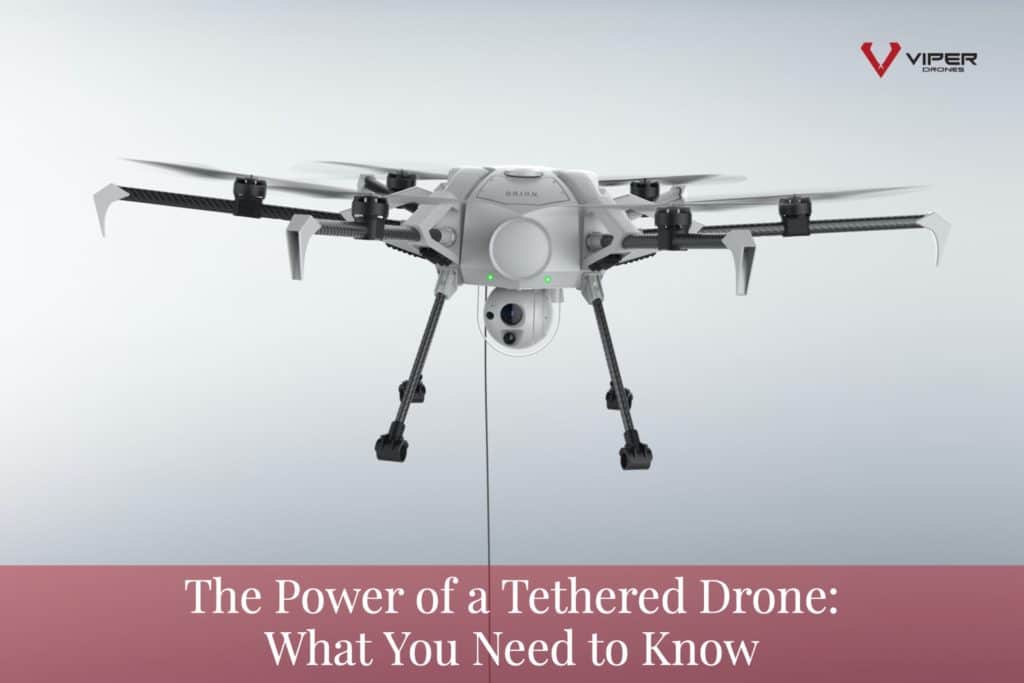
An Introduction To Tethered Drones
The military has utilized drones since the early 2000s, but it was only as recently as 2016 that drone technology received a green light for commercial use.
A drone, frequently referred to as an Unmanned Aerial Vehicle (UAV), is correctly known as a UAS: Unmanned Aerial System.
Most often, the pictures and videos shown in the media depict a drone flying without restrictions above a neighborhood or natural landscape. However, this flying drone is only one type of drone, and it has a variety of surprising uses.
Many companies, services, and people utilize the lesser-known tethered drone solutions.
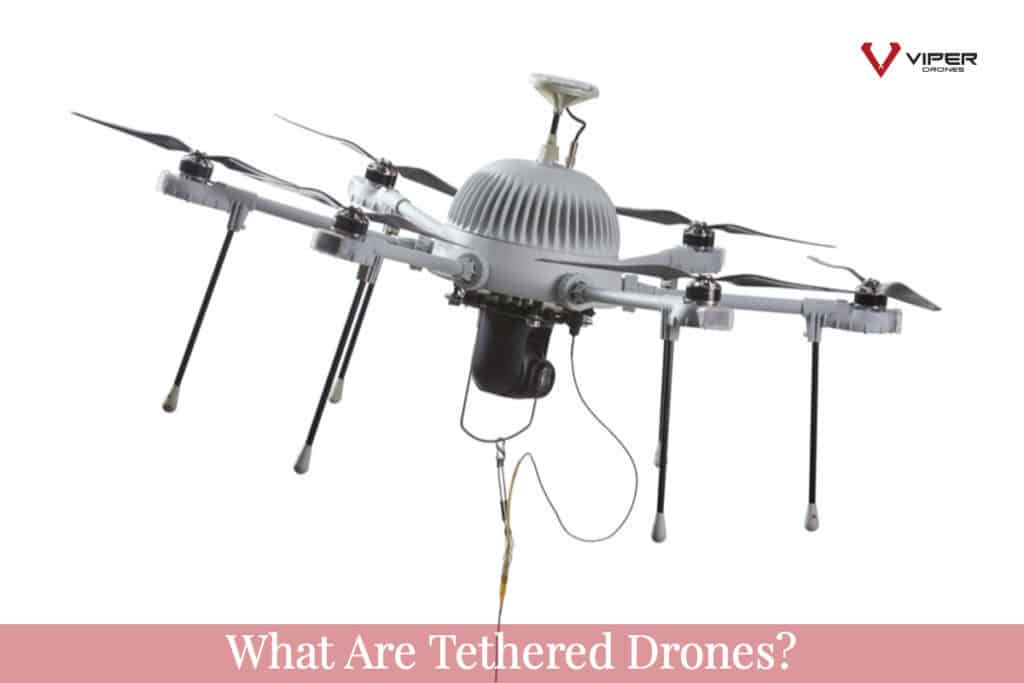
What are Tethered Drones?
Tethered drones are any drone physically connected to a power station on the ground.
There are variations of tethered drones, ranging from a standard drone tethered to the ground using a regular fishing line to programmed drones using a specialized hardware tether. Specialized tethers utilize a high voltage, direct current to operate.
The tether cable contains lightweight and thin conductors, which reduce the wind drag, enabling the drone to reach a higher altitude (around 400 feet).
A Power station (aka drone station or tether station) on the ground converts AC electricity into higher-powered DC. The drone also has a DC-DC converter to supply lower-voltage power to the camera system and other components.
Specifics of operations will vary per company as they have different designs for their tethered drone systems. Tethered drones are also easy to extract and retract using a winch system to which they are typically connected.
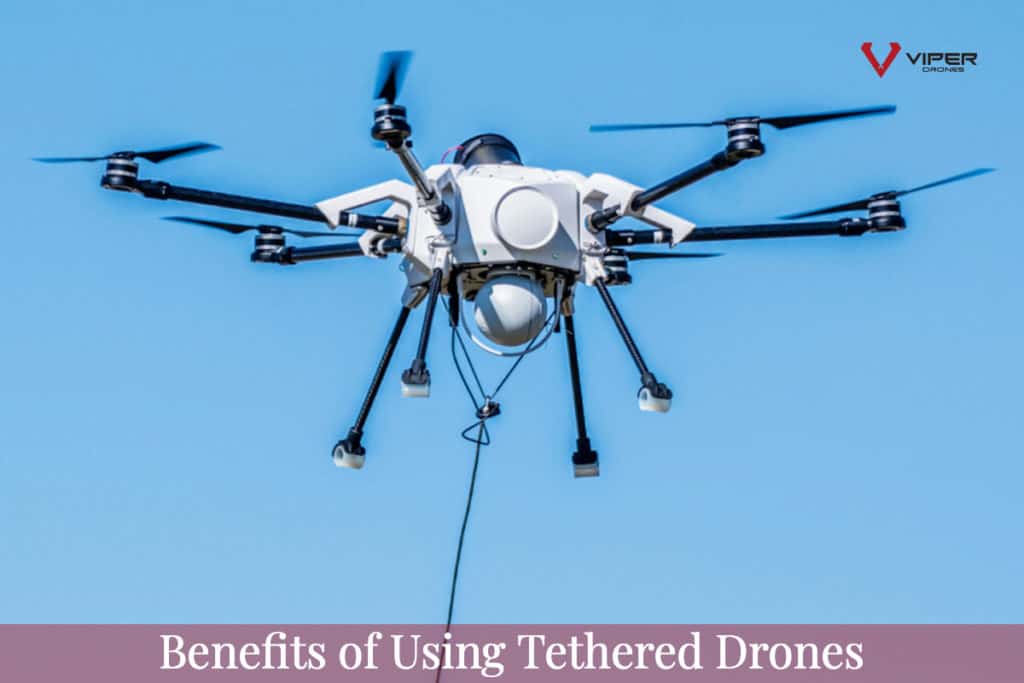
Benefits of Using Tethered Drones
Drone crashes do occur and are often due to technical or human error. However, tethered drones dramatically reduce technical and human error crashes in flight.
A tethered UAS has a reduced spatial area where it can fly.
Because of the flying restrictions the tether creates, and their greater control, their operation does not require a trained pilot.
It also does not require GPS navigation, which significantly contributes to reducing any technical errors that lead to drones crashing.
Flight duration is where they excel. Many tethered drones have longer flight times compared to free-flying, battery-operated drones.
Free-flying drones have an average flight time of twenty minutes on a single, full charge. Most tethered drones have an unlimited flight time and can stay afloat until a problem occurs within the grounded power source, such as a motor or propeller failing.
Another benefit of tethered drones is providing more explicit pictures.
Free-flying drones require a lot of skill and several hours of practice to operate efficiently.
Due to the restricted movement of a tethered drone, the operator does not need piloting skills and can mainly focus on their tasks. In addition, the tether stabilizes drone movement, which enables photographers to capture clear photos and videos; this is especially helpful.
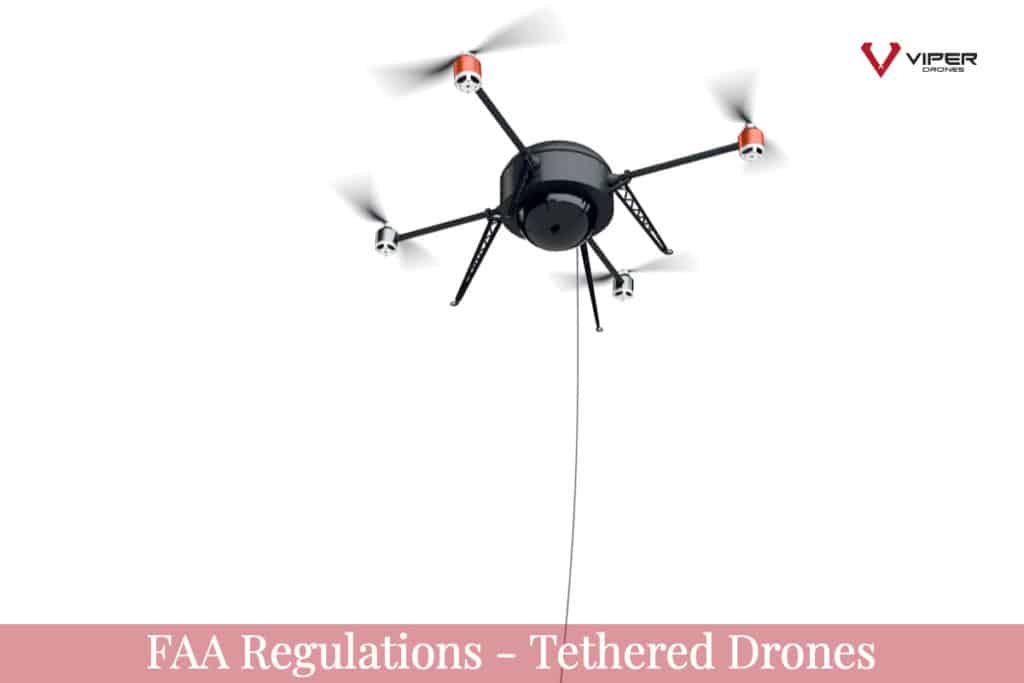
FAA Regulations
The Federal Aviation Administration is in charge of governing and overseeing all aviation activities within the United States.
Free-flying drones are defined as unmanned aircraft, subjecting them to many rules and regulations set by the FAA.
Some have interpreted Tethered drones as falling under the kite or balloon category and thus exempt from FAA regulations. This interpretation is incorrect.
Commercial use of drones was permitted by FAA Rule 107, and Tethered Drones are not exempt.
Countries have different airspace regulations, so following proper protocol when traveling with a drone is always important to avoid penalties.
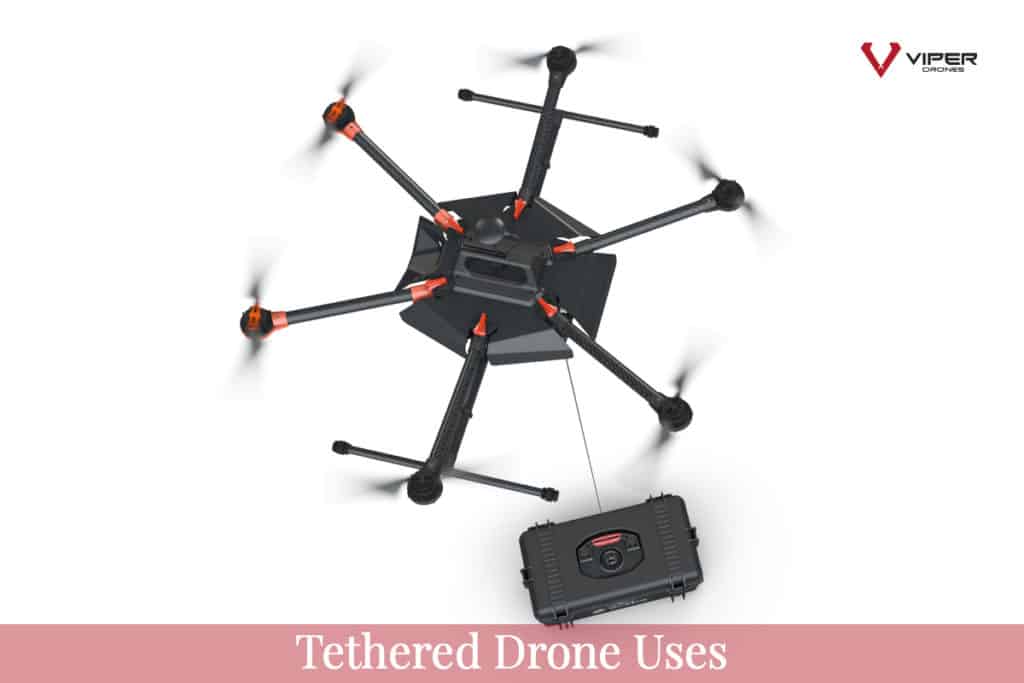
Tethered Drone Uses
Tethered drones are considered Professional Unmanned Aerial Systems. They are a valuable tool with a broad spectrum of capabilities and uses across many fields.
The military, law enforcement, and border patrol use tethered drones as integral to their remote security drone operations.
Drones can cover a large area at once. The operators can monitor activity from the live feedback transmitted to a corresponding tablet or screen on the ground.
This real-time feedback and video aids in criminal aerial surveillance, crowd safety, and military tactics.
A mobilized drone station allows operators to move the flight area without landing the drone first.
Tethered drones are beneficial for search and rescue missions. When tragedy strikes, a drone is a quick and efficient way to gather information about the scene.
Drones equipped with radar and thermal sensors give first responders the needed information for understanding the scope of the disaster and locating trapped survivors.
Their small size also allows them to get close-ups of areas a helicopter could not and drop in needed supplies to rescuers and survivors.
Most notably, tethered drones are used increasingly in real-time journalism, photography, and cinematography. In addition, it is cost-effective and more accessible to deploy than light aircraft or helicopters.
They are also safer to use during demanding situations, whether gathering footage of a natural disaster or war zone.
Drones are also beneficial for scientific purposes such as air quality monitoring or atmospheric measurements.
Geographic mapping is nothing new and has been revolutionized many times over the past few centuries. Drones are the latest technology utilized to gather mapping and surveying data.
Tethered drones don’t cover large areas, but they can collect small-scale information that fixes mapping errors, find population density, and monitor water levels.
They are also used to gather information about the weather, especially tornadic weather and hurricanes.
Tethered drones help collect the insights needed to learn about their behavior and trajectories. They reduce the risk placed on humans when entering dangerous weather.
A surprising use of tethered drones is for precise agriculture.
They can closely monitor crops, which provides the necessary information needed to manage the plants and boost yield.
This crop monitoring can use near-infrared sensors that are tuned to detect the condition of crop health, allowing farmers to make the needed adjustments for the inputs of fertilizer or insecticide to produce better crops.
In general, drones help deploy a broad array of services. Many companies are trying to perfect drones for the use of delivery services and live broadcasts.
They are also becoming increasingly popular in the real estate market as well.
Drone usage will likely increase in the years to come due to their efficiency, easy deployment, and ability to keep people safer.
The commercial drone market has been very robust, growing more than 300% between October 2017 and December 2109. We would expect the tethered drone market segment to show explosive growth as they are adopted for their unique capabilities.
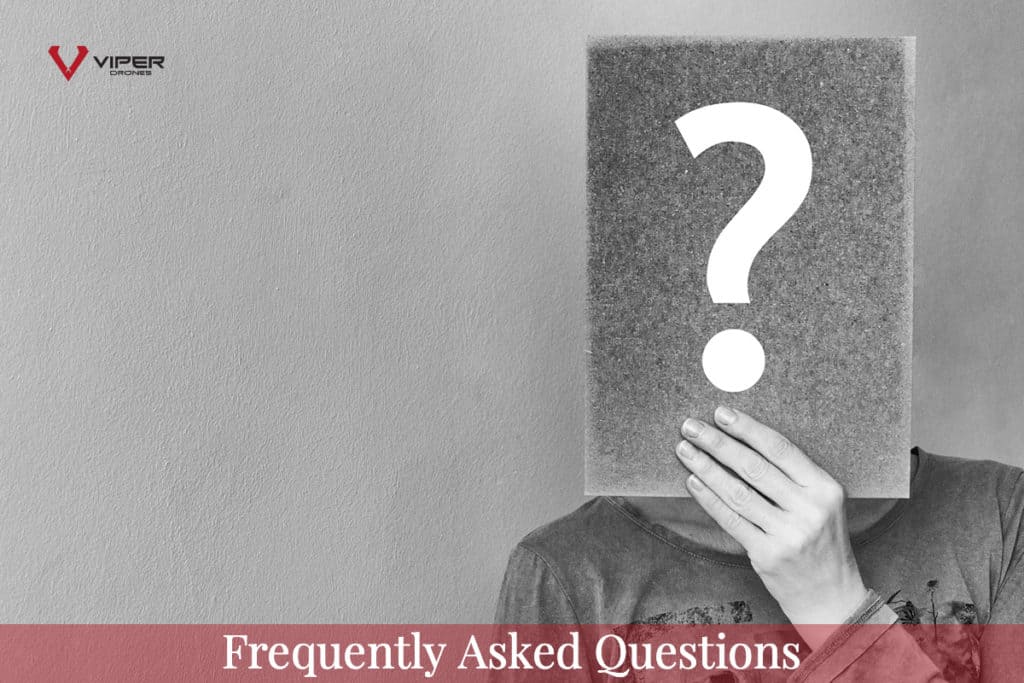
FAQs
How can you get a Tethered Drone System?
There are two ways to get a tethered drone system. The first is a fully integrated system, and the second is a do-it-yourself (DIY) integration.
A fully integrated tethered drone system will include the ground station, winch, tethers, data transmission, communication links, and a drone, plus sensors that were all designed to work together. An integrated Tethered Drone is the most straightforward and most reliable choice, albeit at a higher price than the DIY method.
Do-it-yourself tethered drones require coupling a winch, tether, power, data transmission, and communication system to a drone and ground control station you already own. These solutions are typically less expensive but require an integration that works with your selected drone. It’s relatively easy to find integration kits available for the popular DJI Drones and other manufacturers.
What would a Tethered Drone Cost?
DIY tethered drone systems cost will vary based on the length of the tether, whether the winch is powered or manual, the size of the power supply, and a few other customer-selected variables. DIY tethered drone systems typically range from $2,000 to $50,000, not including the drone and ground control station.
Fully integrated tethered UAVs vary dramatically in cost due to the wide selection of sensors and other variables. They typically range from $20,000 to over $125,000 per complete system, depending on the drone applications.
Which Tethered Drone Companies should you consider?
Elistair is a French and US-based company founded in 2014. Elistair is a market leader in tethered drones supplying both DIY and Integrated systems. They have over 300 customers worldwide using their specialized tethered drone systems, and Elistair’s tethered drone has won several awards and competitions in France and The United States.
Hoverfly Technologies is a Florida-based company. Hoverfly was founded in 2010 and has a long and proven history of innovative and first-to-market technologies, including the first tethered-power sUAS (the LiveSky™), the first optionally tether-powered free-flying drone (the BigSky™), and the first power-tether kit for consumer drones. Hoverfly designs and manufactures tether-powered aerial drones and third-party power tether kits.
Drone Aviation Corp. was founded in 2014 and recently merged with ComSovereign Corp. and is based in Florida. Drone Aviation designs, develops, markets, and sells specialized tethered aerial monitoring and communications platforms serving national defense and security customers for use in situational awareness applications, including intelligence, surveillance, and reconnaissance “ISR”) and communications.
CyPhy Works, founded in 2008, recently rebranded as Aria Insights. The new company focuses on utilizing artificial intelligence and machine learning to help analyze data collected by drones. Aria will build upon CyPhy’s tethered flight data collection system to help pull information in dangerous situations, from oil tankers and pipelines to natural disasters.
There are a number of other unmanned systems companies that, while not directly in the tethered drone systems business, are an integral part of the drone market. They contribute significant additional capabilities, such as specialized sensors or tools, which make unmanned flight more sustainable.
We encourage you to check out FLIR Systems, a reputed Thermal Imaging company, and Aeryon Labs, a software company that is revolutionizing drone data transfer and systems interoperability.
What are the benefits of a Tethered Drone system?
The many benefits of a tethered drone system include:
Persistent Operation: The continuous power delivered to Tethered drones make them persistent systems that can remain airborne for hours, if not indefinitely.
Secure data: The tether means secure communications, unjammable, and immune to interference.
Overt Deterrence: Tethered drones are an overt surveillance deterrent.
Continuous Streaming: Tethered systems allow continuous and interference-free high-quality video broadcasts.
Safe Operation: In crowded areas, public safety is essential. The tethered drone is dramatically more reliable than alternatives.

Leon Shivamber
Partner, Chair
Advisor, Entrepreneur, Strategist, & Transformation Agent. Over a decade of experience with Drone Technology and Solutions.

Brad Nichols
Partner, CTO
30-plus years focused on mission-critical technology and operations. 5+ Years experience with Drone Solutions.

Tom McKeefery
Partner, Managing Director
Transformation, Technology, Supply Chains, and Operations. 5+ years in Drone Technology Businesses.
